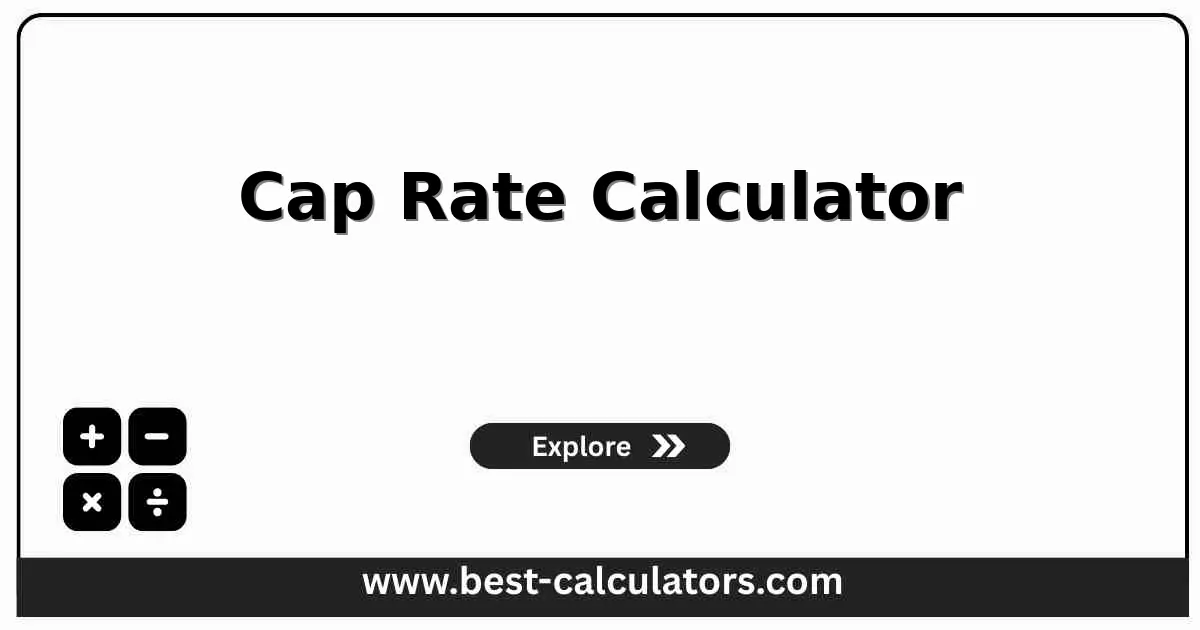Cap Rate Calculator - Calculate Capitalization Rate
Free cap rate calculator to determine capitalization rate for real estate investments with NOI analysis and property valuation
Cap Rate Calculator
Results
What is a Cap Rate Calculator?
A cap rate calculator is a real estate investment tool that calculates the capitalization rate of an income-generating property. The cap rate measures the annual return on investment based on the property's net operating income (NOI) relative to its current market value.
This calculator helps with:
- Investment analysis - Evaluate potential rental property returns
- Property comparison - Compare multiple investment opportunities
- Market valuation - Determine fair market value for properties
- Risk assessment - Understand investment risk levels
- Portfolio management - Analyze existing real estate holdings
For comprehensive property analysis, use our real estate calculator to evaluate cash flow, ROI, and total returns for investment properties.
When analyzing rental income requirements, our rent calculator helps determine affordable monthly rent based on income and location factors.
To compare buying versus renting decisions, explore our rent vs buy calculator for complete financial analysis.
How Cap Rate Works
The cap rate calculation uses a simple but powerful formula to measure investment property performance:
Where:
- NOI = Net Operating Income (Annual Income - Operating Expenses)
- Property Value = Current market value or purchase price
- Cap Rate = Percentage return on investment
Example: A property with $50,000 annual rental income, $20,000 operating expenses, and $400,000 value has a cap rate of 7.5% [($50,000 - $20,000) ÷ $400,000 × 100 = 7.5%].
This indicates the property generates a 7.5% annual return before mortgage financing costs.
Key Concepts Explained
Net Operating Income (NOI)
Total rental income minus all operating expenses excluding mortgage payments. Represents actual cash flow from property operations.
Operating Expenses
Costs to maintain and operate the property including taxes, insurance, maintenance, utilities, and property management fees.
Capitalization Rate
Percentage expressing annual return on investment. Higher rates indicate potentially higher returns but increased risk.
Market Comparison
Comparing cap rates across similar properties helps identify undervalued opportunities and market trends in specific areas.
How to Use This Calculator
Enter Rental Income
Input total annual rental income received from the property (e.g., $50,000)
Enter Operating Expenses
Input annual costs including taxes, insurance, maintenance, and management fees (e.g., $20,000)
Enter Property Value
Input current market value or intended purchase price of the property (e.g., $400,000)
Review Cap Rate
Instantly see calculated cap rate percentage and NOI to evaluate investment quality
Compare Properties
Use the calculator to compare multiple properties and identify the best investment opportunities
Assess Market Value
Compare your calculated cap rate against local market averages to determine fair pricing
Benefits of Using Cap Rate Calculator
- • Quick Investment Analysis: Instantly evaluate property profitability without complex financial modeling or spreadsheets.
- • Objective Comparison: Compare multiple properties on equal footing using standardized cap rate metrics across markets.
- • Risk Assessment: Understand investment risk levels through cap rate analysis before committing capital to purchases.
- • Market Valuation: Determine if properties are fairly priced based on income generation and local market cap rates.
- • Portfolio Optimization: Monitor existing investments and identify underperforming properties that need attention or disposition.
- • Negotiation Power: Use cap rate analysis to support purchase price negotiations with data-driven investment metrics.
Factors That Affect Your Cap Rate
1. Location & Market Conditions
Prime locations typically have lower cap rates (4-6%) due to stability, while emerging markets offer higher cap rates (8-12%) with increased risk.
2. Property Type & Condition
Class A properties command lower cap rates, while older properties requiring maintenance generate higher cap rates to compensate for risk.
3. Operating Expenses
Higher expenses reduce NOI and cap rate. Well-maintained properties with efficient management typically have better cap rates.
4. Rental Income Stability
Properties with long-term tenants and consistent occupancy rates provide more stable cap rates and reliable investment returns.
5. Economic Trends
Interest rates, employment levels, and local economic growth significantly impact cap rates and property values over time.

Frequently Asked Questions (FAQ)
Q: What is a good cap rate for investment property?
A: Good cap rates range from 4-10%. Higher rates (8-12%) suggest higher returns but more risk. Lower rates (4-6%) indicate stable investments in prime locations.
Q: How do you calculate cap rate?
A: Divide Net Operating Income (NOI) by property value, then multiply by 100. Formula: Cap Rate = (NOI ÷ Property Value) × 100.
Q: What expenses are included in NOI?
A: NOI includes operating expenses like taxes, insurance, utilities, maintenance, and management fees. Excludes mortgage payments and capital expenditures.
Q: Is a higher cap rate better?
A: Higher cap rates offer better potential returns but come with increased risk. Lower cap rates suggest safer investments in established markets.
Q: Can cap rate be negative?
A: Yes, if expenses exceed rental income (negative NOI), the cap rate will be negative, indicating the property is losing money.
Q: What's the difference between cap rate and ROI?
A: Cap rate measures property performance independently of financing. ROI includes leverage and financing costs, showing total return on invested capital.